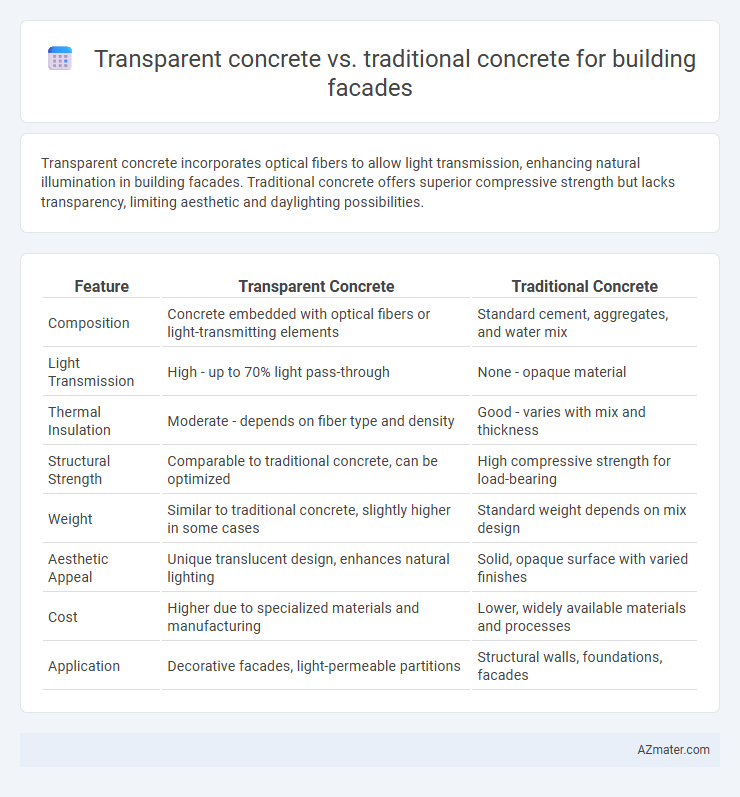Transparent concrete incorporates optical fibers to allow light transmission, enhancing natural illumination in building facades. Traditional concrete offers superior compressive strength but lacks transparency, limiting aesthetic and daylighting possibilities.
Table of Comparison
| Feature | Transparent Concrete | Traditional Concrete |
|---|---|---|
| Composition | Concrete embedded with optical fibers or light-transmitting elements | Standard cement, aggregates, and water mix |
| Light Transmission | High - up to 70% light pass-through | None - opaque material |
| Thermal Insulation | Moderate - depends on fiber type and density | Good - varies with mix and thickness |
| Structural Strength | Comparable to traditional concrete, can be optimized | High compressive strength for load-bearing |
| Weight | Similar to traditional concrete, slightly higher in some cases | Standard weight depends on mix design |
| Aesthetic Appeal | Unique translucent design, enhances natural lighting | Solid, opaque surface with varied finishes |
| Cost | Higher due to specialized materials and manufacturing | Lower, widely available materials and processes |
| Application | Decorative facades, light-permeable partitions | Structural walls, foundations, facades |
Introduction to Transparent and Traditional Concrete
Transparent concrete incorporates optical fibers or light-transmitting materials embedded within the cement matrix, allowing natural light to pass through while maintaining structural integrity. Traditional concrete, composed of cement, aggregates, water, and additives, offers high compressive strength and durability but lacks translucency. The innovative design of transparent concrete enhances aesthetic appeal and lighting efficiency for building facades compared to the opaque nature of traditional concrete.
Composition and Material Differences
Transparent concrete incorporates optical fibers or light-transmitting elements embedded within a cementitious matrix to allow light passage while maintaining structural integrity, contrasting with traditional concrete's opaque mix of cement, sand, aggregates, and water. The composition of transparent concrete typically includes fine aggregates and specifically aligned optical fibers that channel natural or artificial light, resulting in enhanced aesthetic appeal and partial translucency. Traditional concrete relies on a dense combination of coarse and fine aggregates which offer higher compressive strength but no light transmission capability, making it suitable for load-bearing facades without visual openness.
Light Transmission Capabilities
Transparent concrete incorporates optical fibers or light-transmitting elements that allow up to 70% of natural light to pass through, enhancing interior illumination without compromising structural integrity. Traditional concrete is opaque, blocking light entirely and necessitating artificial lighting to brighten building interiors. The advanced light transmission capabilities of transparent concrete contribute to energy savings and improved aesthetic appeal in building facades.
Aesthetic and Architectural Design Potential
Transparent concrete offers unique aesthetic possibilities by integrating optical fibers that transmit light, enabling dynamic facades with natural illumination and visually striking effects unlike traditional concrete's opaque, solid appearance. The ability to customize patterns and light intensity in transparent concrete enhances architectural design potential, allowing innovative concepts such as light-permeable walls and interactive surfaces. Traditional concrete focuses more on texture, color, and form but lacks the light-transmitting properties that expand creative options for modern building facades.
Structural Strength and Durability Comparison
Transparent concrete incorporates optical fibers that maintain structural strength comparable to traditional concrete while offering enhanced aesthetic appeal for building facades. Traditional concrete demonstrates higher compressive strength ranging from 20 to 40 MPa, whereas transparent concrete typically exhibits slightly reduced strength due to fiber integration but remains suitable for non-load-bearing facade elements. Durability of transparent concrete aligns closely with conventional concrete, showcasing resistance to weathering and corrosion, though fiber-reinforced composite materials require careful sealing to prevent optical fiber degradation over time.
Energy Efficiency and Sustainability
Transparent concrete incorporates optical fibers to allow natural light transmission, reducing the need for artificial lighting and lowering energy consumption in building facades. Traditional concrete lacks this light-transmitting property, often necessitating higher energy use for illumination and climate control. Utilizing transparent concrete enhances sustainability by improving daylight utilization and contributing to energy-efficient building design.
Installation and Construction Methods
Transparent concrete incorporates optical fibers or resin-based components embedded within traditional concrete, requiring specialized casting and fiber alignment during installation to ensure light transmission properties. Traditional concrete uses conventional mixing and formwork methods, offering straightforward placement and curing processes but lacking translucency. Installation of transparent concrete demands precise handling and integration techniques to maintain structural integrity and aesthetic functionality in building facades.
Cost Analysis and Economic Considerations
Transparent concrete, incorporating optical fibers or resin-based materials, generally incurs higher initial costs compared to traditional concrete due to advanced manufacturing and material expenses. Long-term economic benefits include energy savings from improved natural lighting and potential reductions in artificial lighting costs, potentially offsetting upfront investments. Traditional concrete remains more cost-effective for large-scale applications where transparency and light transmission are not critical factors.
Applications in Modern Building Facades
Transparent concrete incorporates optical fibers that allow light transmission, making it ideal for innovative building facades requiring natural illumination without compromising structural integrity. Traditional concrete is favored for its durability and load-bearing capacity but lacks translucency, limiting creative lighting applications in modern architecture. In contemporary design, transparent concrete enhances aesthetic appeal and energy efficiency by reducing the need for artificial lighting, while traditional concrete remains a cost-effective material for robust facade construction.
Future Trends and Innovations
Transparent concrete integrates optical fibers or photoluminescent materials, enabling natural light transmission and energy-efficient building facades, which traditional concrete lacks. Future trends emphasize smart transparent concrete with self-cleaning, thermal regulation, and electromagnetic shielding properties, enhancing sustainability and occupant comfort. Innovations also include embedding sensors for structural health monitoring, positioning transparent concrete as a transformative material in modern architectural design.

Infographic: Transparent concrete vs Traditional concrete for Building facade
 azmater.com
azmater.com